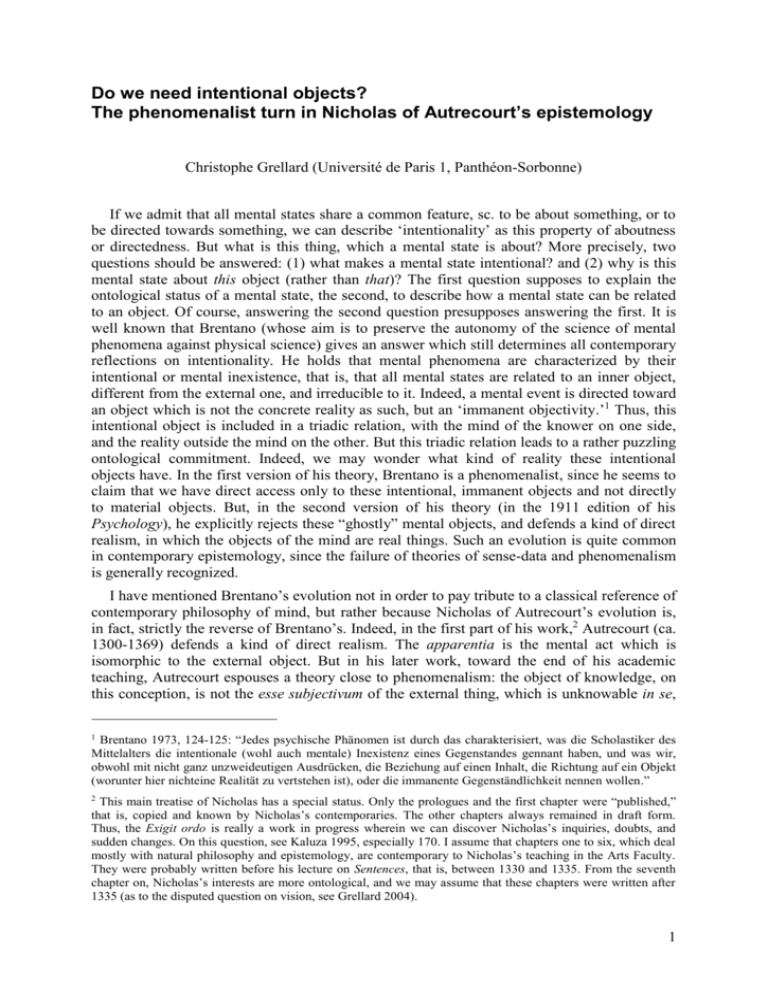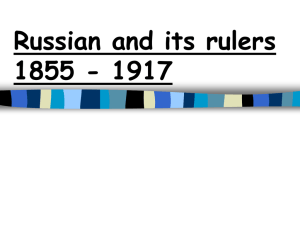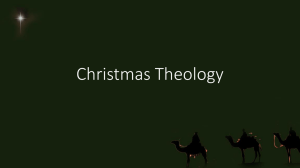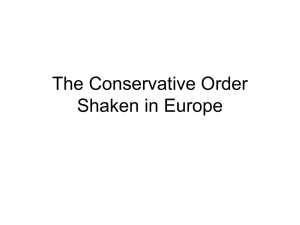Do we need intentional objects? The phenomenalist turn in Nicholas
advertisement

Do we need intentional objects? The phenomenalist turn in Nicholas of Autrecourt’s epistemology Christophe Grellard (Université de Paris 1, Panthéon-Sorbonne) If we admit that all mental states share a common feature, sc. to be about something, or to be directed towards something, we can describe ‘intentionality’ as this property of aboutness or directedness. But what is this thing, which a mental state is about? More precisely, two questions should be answered: (1) what makes a mental state intentional? and (2) why is this mental state about this object (rather than that)? The first question supposes to explain the ontological status of a mental state, the second, to describe how a mental state can be related to an object. Of course, answering the second question presupposes answering the first. It is well known that Brentano (whose aim is to preserve the autonomy of the science of mental phenomena against physical science) gives an answer which still determines all contemporary reflections on intentionality. He holds that mental phenomena are characterized by their intentional or mental inexistence, that is, that all mental states are related to an inner object, different from the external one, and irreducible to it. Indeed, a mental event is directed toward an object which is not the concrete reality as such, but an ‘immanent objectivity.’1 Thus, this intentional object is included in a triadic relation, with the mind of the knower on one side, and the reality outside the mind on the other. But this triadic relation leads to a rather puzzling ontological commitment. Indeed, we may wonder what kind of reality these intentional objects have. In the first version of his theory, Brentano is a phenomenalist, since he seems to claim that we have direct access only to these intentional, immanent objects and not directly to material objects. But, in the second version of his theory (in the 1911 edition of his Psychology), he explicitly rejects these “ghostly” mental objects, and defends a kind of direct realism, in which the objects of the mind are real things. Such an evolution is quite common in contemporary epistemology, since the failure of theories of sense-data and phenomenalism is generally recognized. I have mentioned Brentano’s evolution not in order to pay tribute to a classical reference of contemporary philosophy of mind, but rather because Nicholas of Autrecourt’s evolution is, in fact, strictly the reverse of Brentano’s. Indeed, in the first part of his work,2 Autrecourt (ca. 1300-1369) defends a kind of direct realism. The apparentia is the mental act which is isomorphic to the external object. But in his later work, toward the end of his academic teaching, Autrecourt espouses a theory close to phenomenalism: the object of knowledge, on this conception, is not the esse subjectivum of the external thing, which is unknowable in se, Brentano 1973, 124-125: “Jedes psychische Phänomen ist durch das charakterisiert, was die Scholastiker des Mittelalters die intentionale (wohl auch mentale) Inexistenz eines Gegenstandes gennant haben, und was wir, obwohl mit nicht ganz unzweideutigen Ausdrücken, die Beziehung auf einen Inhalt, die Richtung auf ein Objekt (worunter hier nichteine Realität zu vertstehen ist), oder die immanente Gegenständlichkeit nennen wollen.” 1 This main treatise of Nicholas has a special status. Only the prologues and the first chapter were “published,” that is, copied and known by Nicholas’s contemporaries. The other chapters always remained in draft form. Thus, the Exigit ordo is really a work in progress wherein we can discover Nicholas’s inquiries, doubts, and sudden changes. On this question, see Kaluza 1995, especially 170. I assume that chapters one to six, which deal mostly with natural philosophy and epistemology, are contemporary to Nicholas’s teaching in the Arts Faculty. They were probably written before his lecture on Sentences, that is, between 1330 and 1335. From the seventh chapter on, Nicholas’s interests are more ontological, and we may assume that these chapters were written after 1335 (as to the disputed question on vision, see Grellard 2004). 2 1 but the esse objectivum of the object in the mind. Thus, we find here the same triadic relation as in Brentano’s first theory. Hence, we may wonder why Nicholas follows such a path, rejecting direct realism for phenomenalism.3 To answer this question, we may propose two main reasons: First, the principal interest of the phenomenalist theory (as it appears in the theory of sense-data or Brentano’s first thesis) is to explain how a mental state can be about something even when there is nothing corresponding to it outside the mind. Indeed, Nicholas wants to give a uniform account of all mental states. Hence, even if in his first theory intentional objects are used only in the case of illusions, while in veridical cases the mental state is directly about a real object, in his second theory, intentional objects are utilized to account for all kinds of perception (whether sensory or intellectual). The second reason for his shift is not epistemological but ontological; by the end of his career, Nicholas seems to assent more firmly to a Platonic conception of reality in which only separate principles can be called ‘real.’ By examining the case of Nicholas, which is certainly not an isolated one,4 I would like to investigate the reasons why anyone would need intentional objects, and to determine who needs such objects. My claim is that phenomenalism is firmly connected to a certain kind of ontology. 1. The failure of direct realism Since I claim that Nicholas changed his position from direct realism to phenomenalism, I shall explain why he may have done so. My aim will be first to show what could be the failure of direct realism according to Autrecourt. My thesis is that Nicholas changed his mind because of some ontological considerations. In the sixth chapter of the Exigit ordo, entitled “Whether all that appears is true?”, Nicholas examines the problem of the truth of our perception. In this perspective, he has to confront the skeptical challenge and to explain how our experiences could be wrong. His answer relies on a strict separation between the veridical perception directed towards a real thing outside the mind, and the false perception directed towards an image of the thing, that is something unreal that exists only in the mind. Thus, the intentionality of the perception does not require an intentional object-theory, except in the exceptional cases of illusions. 1.1. What is ‘apparentia’? The key notion in Nicholas’s first epistemology, as expounded in the sixth chapter of the Exigit ordo, is the concept of apparentia. As is well known, apparentia is above all a normative concept and the foundation of Autrecourt’s general trust in sensory cognition: all that appears to our external senses under good conditions is true. Nevertheless, this principle cannot be proved, but can only be assumed as true if we want to have any certitude about the external world. Hence, appearance is immediately connected with the problem of certitude 3 In Grellard 2005, I was not fully aware of this evolution and I tried to give a unitary and systematic account of Nicholas’s entire philosophy. I give some arguments for the evolution thesis in both Grellard 2004 and Grellard 2006. This thesis is challenged by Dallas Denery in Denery 2005 and Denery 2006. In my opinion, Denery’s thesis is weakened by the fact that he never explains why Nicholas stops using the notion of apparentia in the last part of the Exigit ordo, and by the fact that he does not take a clear position on the opposition of direct realism and phenomenism. 4 See, for example, Perler 2001. 2 and with the claim that we usually do have such certitude. But how can appearance lay claim to this kind of certitude? Nicholas’s answer is clear on this point: all sensory appearance “in the full light” (that is, under optimal conditions) has a necessary relation with its object. Such a relation warrants us to hold that the object of our knowledge actually exists and that we are not deceived. In brief, a true and evident appearance is a mental state which occurs if and only if (1) the external senses are affected by an object, (2) this object actually exists and is present, (3) the external and internal conditions of the apprehension are optimal, and (4) a necessary relation is produced between the mental state and the object. Of course, the question is: how can we know that we are under the optimal conditions of perception? Nicholas answers that we just do know it. An evident appearance is strong enough to lead to assent and impose its own evidentness. If there is any doubt, we should say that the perception is not “in the full light.” Admittedly, this general theory of perception is indifferent to direct realism or phenomenalism, since it gives us only the internal conditions of certitude.5 Now, how can we connect the notion of appearance with direct realism? To answer this question, we have to consider the nature of appearance and determine why a given appearance is about a given object. At one point, Nicholas defines appearance as “the configuration of the object” (configuratio objecti). He also clearly holds that any object can be grasped by means of different configurations, depending on the way in which we perceive the object. Unfortunately, Nicholas does not tell us precisely what such a configuration is. But we may assume that this is a kind of likeness, even though, as we will see below, our mental state is not properly an image of the thing. It seems that the best way to understand such a likeness depends on the atomistic theory of perception which Nicholas develops. Indeed, Nicholas claims that, just as material atoms move and come together to form a body, spiritual atoms gather to form a mental act suitable to an external thing which is grasped: Yet one must know that the combination of such spiritual atomic beings sometimes turns out inharmonious, sometimes harmonious. Just as external material things because of disharmony or harmony in their combination are sometimes said to be monstrosities, sometimes to be composed well, so in the case of the soul an inharmonious combination is called a false composition, a harmonious one (i.e. when it is properly related to what is in reality outside) a true composition.6 Hence, the mental act is built from spiritual atoms which are perceived not by themselves but only as a whole. And this construction corresponds to another external one. Two questions remain to be solved: How is this atomic construction possible and how can such a spiritual compound correspond to external reality? To answer these questions, Nicholas relies on his reductionist conception of natural events, according to which all phenomena depend on the local motion of atoms.7 There is no exception when we turn towards psychological events. Hence, perception is explained by the diffusion of some sort of atoms from the thing to the senses, in the same way as a species sensibilis: 5 I assume that Nicholas defends an internalist and foundationalist theory of knowledge. See, Grellard 2005, especially chap. 2, 3 and 9. Autrecourt 1971, 70; Autrecourt 1939, 205, 42 – 206, 2: “Sciendum tamen quod aliquando fit congregatio talium entium atomalium spiritualium disconveniens, aliquando conveniens, et sicut in rebus materialibus extra, propter disconvenientiam <et convenientiam> in congregatione dicuntur interdum monstra interdum bene composita, sic et in anima propter congregationem disconvenientem dicitur … compositio falsa; propter convenientiam vera cum est modo convenienti ei quod est extra in re.” 6 7 See Grellard 2002 and Grellard forthcoming (1). 3 In connection with the act of seeing one must reckon with a twofold power. One is more corporeal, which unites the spirits and the visual rays. In or by their union the species is conveyed right to the organ of sight. Whether it be for receiving the species or for whatever other purpose, it is certain that such a union of spirits is prerequisite to the act of seeing. Only after this should we consider the power of the soul which elicits the act of seeing.8 Nicholas assumes that the human body contains two main spiritual atoms, one called “sense” and the other “intellect.” These two atoms, respectively, receive material and spiritual (that is, less material) exemplars, so that the sense-atom produces an atomic image from these exemplars, and then the intellect-atom builds a universal exemplar. Therefore, the atomic construction is the result of the local motion of atoms to the senses and from them to the intellect. And the same atoms, in a spiritual form, are the constituents of our image of the thing. Hence, the relation between the atomic image and the external compound is founded on a structural likeness. Now, what is the object of such knowledge? Is it the atomic compound outside the mind, or the atomic image inside the mind? We may assume that, for Autrecourt, spiritual exemplars have no representational properties, but only sensational ones.9 Indeed, an atom by itself cannot be perceived. It is known only when it acts in a compound. It should be the same for exemplars: they affect the senses but are not perceived. Hence, the image is not the object of perception, but what allows us to have a perception. To prove this last point, Nicholas carefully examines the case when we perceive the image and not the thing, that is, the case of illusions. Direct realism is established at this level. 1.2. The problem of illusions As we have seen, according to Nicholas, veridical perception depends on the conformity between a mental state and a thing outside the mind. This relation requires that the thing actually exists, and that it is perceived by the senses. Nevertheless, we have all experienced cases when we are convinced we perceive something real when in fact nothing of that sort exists in front of us. The problem here is to determine when our appearance is “in the full light,” and to explain how it can be not “in the full light.” Nicholas carefully examines the arguments frequently discussed in the Middle Ages concerning the reliability of the senses. There are two kinds of arguments: first, relativist arguments arguing from variation in taste or sight; and, second, skeptical arguments based on illusion and hallucination (like the broken stick, the size of the sun, and the moving tree seen from a boat), the dream argument, and the argument from disagreement. All these arguments are discussed by Peter Aureole, on whom Nicholas clearly depends.10 On the first approach, Nicholas tries to evade these arguments by means of the classical distinction between perception and judgment. Relativist arguments demand an a posteriori answer, namely, the correction of some judgment by reference to other correct appearances. In other words, different cognitive faculties have to be consistent with each other.11 But for our purposes, Autrecourt 1971, 162; Autrecourt 1939, 265, 7-12: “Circa actum videndi est considerare duplicem virtutem, unam magis corporalem unitivam spirituum et radiorum visualium in quibus unitis vel quibus unitis fit delatio speciei usque ad organum visus, sive sit propter receptionem speciei, sive propter quodcumque aliud, certum est quod ad actum videndi prarequiritur talis unio spirituum, postea consideranda est quaedam virtus animae eliciens actum videndi.” 8 9 On this distinction, see Peacocke 1983, 5. 10 See Denery 2005, Thijssen 2001. In my former studies (Grellard 2005, Grellard 2006), I have unduly underestimated Aureole’s influence on Autrecourt’s thought. 11 On this point, see Grellard forthcoming (2). 4 Nicholas’s second approach is much more interesting since it relies on the atomist theory of perception. Nicholas’s aim is to carefully distinguish between the image of the thing and the thing itself as the term of an intentional act. Hence, he claims that under normal conditions, the perceptual act is about the thing itself, while in situations of illusion, perception is about the image of the thing. Indeed, our perception of the external world is made of a multitude of spiritual motions, that is, atomic emanations from things to our senses. But, as soon as we perceive several things simultaneously, the multiplication of the motions weakens our faculties and disturbs them. Therefore, spiritual atoms will be imperfectly grasped and the images made of them will also be imperfect, that is, partial: These spirits, some of which carry the image of one thing, and others the image of another thing, can impede one another in their movement. Then the image of neither thing is carried without mutilation. It is men in this condition who judge of things defectively and imperfectly.12 Mutual distraction among the spiritual movements is the main physiological cause of misperception. Since the atomic image of the thing is truncated, it cannot have any relation of conformity with the thing, and any judgment founded on this appearance will be defective. In this case, there is a gap between the appearance and the thing, and the appearance does not have the thing itself as an object but only the image of the thing. In this way, Nicholas can give an atomistic account of sensible illusions or delusions. In the case of the broken stick or the moving tree, the appearance we have is not of the real thing, called the res fixa, but of a changing image. When we say that the stick is broken or the tree is moving, we do not speak about the thing, but about the environment or the context in which we perceive it, and the way in which we are affected. All these perceptions need to be corrected by other perceptions, e.g. the tactile sensation of the stick, or the perception of the tree from a fixed point of view, or even by a mathematical concept as in the case of the sun’s size. The case of ill taste is slightly different, but also depends on this atomist theory. Exemplars in the organ usually have a relation of conformity with the corresponding atoms in the thing which move them (e.g. with atoms of sweetness in honey13). But if the organ is modified by illness, the nature of the exemplars will change, and we will no longer have any kind of conformity. Finally, it appears that when some atoms are lacking, the atomic image or configuration of the object will not be complete. In this case, the appearance is of the image of the thing, not the thing itself.14 Nicholas compares this situation to that of a man looking at himself in a mirror.15 This man will have indirect access to the thing. Conversely, when the appearance is complete, that is, “in the full light,” there is no difference between the image of the thing and the thing, and we have direct access to the thing. The appearance, that is, the mental state, directly refers to the thing outside the mind without any intermediate entity. Hence, Nicholas is able to answer the two questions raised at the beginning. First, what makes the mental state Autrecourt 1971, 146; Autrecourt 1939, 254, 44-47: “Spiritus isti quorum aliqui deferunt imaginem istius rei, alii imaginem alterius rei in suo motu ad invicem possunt se impedire, et tunc neutrius affertur imago rei nisi truncate; et isti sunt qui truncate et imperfecte judicant de rebus.” 12 13 Significantly, Autrecourt supports qualitative atoms in his theory. See Grellard 2005, 214-218 and Grellard forthcoming (1). Autrecourt 1939, 232, 2-3: “illa apparentia terminatur ad imaginem rei et non ad aliquid existens subjective in re extra.” On this point, the influence of Peter Aureole’s distinction between the thing and the esse apparens is manifest. 14 Autrecourt 1939, 231, 24-26: “sed sciendum propter quaedam alia quod aliquando dicitur videri res in suo proprio lumine, aliquando in lumine sui imaginis ut cum homo videtur in speculo.” 15 5 intentional is the movement of spiritual atoms. So, we need no special ontological items to explain intentionality, but only spiritual and material atoms in movement. Second, a mental state is about this object rather than that, because its configuration is isomorphic to the object’s and shares the same atomistic structure. 1.3. Ontological models for perception It seems clear enough that Autrecourt’s version of direct realism is connected to his atomism. The key to understanding Nicholas’s thought is a text at the beginning of the Exigit ordo, in the first chapter, On the Eternity of Things. Here, Nicholas examines how things can be said to be eternal, and tries to determine the existential import of appearance. Can we make an inference such as “the thing has ceased to appear, therefore the thing no longer exists”? In order to reject this inference, Nicholas introduces three ontological models for explaining what is perceived. The first one is the atomistic model: The first way seems to me to be more probable than the others, even though I do not have an evidently demonstrative conclusion. Here it is: ‘As regards the major premise16, let it be said that it does not contain truth. For natural forms are divisible into their smallest units in such a way that these, when divided off from the whole, could not perform their proper action. And so, though they are visible when existing in the whole, they are not visible when dispersed and divided or separated. For this is true even according to the mind of Aristotle when he says that natural beings have a maximum and a minimum limit.17 Atoms are the real things (vera entia) and are only perceptible when they are acting together in a whole. When they are separated from a compound, they cannot act and do not appear to us. This atomistic explanation is labeled the most probable. There are also two other ways. The second could also be understood as a form of atomism, or at least is not inconsistent with atomism; it states that in each thing there is a power of movement (potentia or virtus). When this power is at rest, the thing does not appear. Later on, Nicholas interprets this power as a particular kind of atom that is an essential part moved by celestial bodies.18 Hence the two models first are both atomistic, but with a greater or lesser mechanistic emphasis, since the notion of power is not really mechanistic: The second way would be to say that the case is analogous with the power of movement, which sometimes performs its act and sometimes is at rest. When it functions, it appears. When it is at rest, it does not appear, but it is not therefore said to be destroyed. 19 The last possible explanation places atoms in the realm of Platonic ideas. This theory assumes that when two people see some whiteness, they see exactly the same one Whiteness. Indeed, we may imagine that, if several mirrors were put around the same person, that very same person would appear in each mirror. For Nicholas, the situation is the same in the case of Nicholas is criticizing the following argument: “Everything which previously appeared to a sense but now does not appear, no matter what the sense fixes its attention on, no longer exists. But this is the case with the whiteness which previously appeared but now does not appear. Therefore, etc.” (Autrecourt 1971, 61). 16 Autrecourt 1971, 61; Autrecourt 1939, 199, 40-46: “primus modus inter alios mihi probabilior esse videtur, licet non habeam conclusionem evidenter demonstrantem, et est hic: dicatur ad majorem quod veritatem non continet; nam formae naturales sunt ita divisibiles in minima quod seorsum divisa a toto non possent habere actionem suam et ita licet ipsa existentia in toto videantur, dispersa tamen et divisa seu segregata non videntur. Hoc enim veritatem habet etiam secundum intellectum Aristotelis dicentis: entia naturalia esse terminata ad maximum et minimum.” 17 18 See Grellard 2002 and Grellard forthcoming (1). Autrecourt 1971, 61; Autrecourt 1939, 200, 47 – 200, 1: “Secundus modus esset ut diceretur quod sicut potentia motiva aliquando habet actum suum, hoc est quando movet est in apparentia, et aliquando quiescit, et tunc non est in apparentia, et tamen propter hoc non dicitur quod sit corrupta.” 19 6 perception: what we directly perceive is the reflection of the real whiteness, which is the separate Whiteness. Material things only reflect the action of separated principles. When the latter cease to act, material things stop reflecting them and do not appear. This radically Platonic claim would lead us to assume that the material world is only a world of images or phenomena and that reality is on the side of separated ideas: The third way would be to say that no reason [ratio] for a thing’s appearance is lost. (…). For place in front of or around you several mirrors in diverse places. According to the common doctrine, if you fix your gaze in one direction, you will see yourself and nothing else formally inhering in the mirror. Similarly, if you look in another direction, you will see yourself. Thus in looking in diverse directions you will see something which will not be in numerically diverse places. So in the case under discussion the position might be stated that there are only material things in this physical reality [hic inferius], and that separated principles are responsible for the actions of things, as Plato claimed, as for example, a separated whiteness for the action of this whiteness (…). And then the material thing that is looked at is only a sort of mirror in which Whiteness can be seen when the gaze is fixed in that direction. This is how Plato understands it.20 At this stage of the argument, Nicholas merely asserts that such a claim is possible, but he prefers to adopt the first, strictly atomistic, hypothesis. Indeed, the subsequent chapters of Exigit ordo clearly rely on a materialist, atomistic mechanism. However, from Chapter 7 on, the Platonic hypothesis comes back and progressively becomes more and more prominent. Therefore, my hypothesis is that the failure of direct realism in the Ultricurian epistemology is linked to the failure of atomism as a convenient explanation of nature. In the course of this discussion, Autrecourt keeps hesitating between Democritus and Plato, but in the end he chooses the latter.21 Eventually, Nicholas recognizes the failure of atomism.22 This failure leads Nicholas to adhere firmly to Platonism and to modify his conception of reality and of the perception of reality. 2. What is reality? A phenomenalist answer Beyond the partial failure of atomism, Nicholas seems to have changed his stance on our apprehension of reality because of a change of paradigm: a new reflection on clarity. Indeed, Autrecourt 1971, 61-62; Autrecourt 1939, 200, 7-40: “Tertius modus ut diceretur quod a nulla re substrahitur ratio apparentiae (…). pone ante vel circa te plura specula ad diversa ubi, secundum doctrinam communem si defingas aspectum tuum ad unum ubi, videbis te et nihil aliud formaliter inhaerens speculo. Similiter si aspicias ad aliud ubi, videbis te et sic aspiciendo ad diversa ubi videbis aliquid quod non erit in diversis locis numero; et sic in proposito diceretur ponendo quod hic inferius non est nisi materiale et quod actiones rerum reducuntur in principia separata quemadmodum ponebat Plato; puta actio albedinis hujus in albedinem separatam (...), tunc non est illud materiale ad quod aspicitur nisi ut speculum, ita quod ad illud ubi defingendo aspectum nata est albedo videri; et iste est intellectus Platonis. Uterque istorum modorum trium possibilis est, nec video quod ab Aristotele sufficienter fuerit aliquis eorum reprobatus; primum tamen pro nunc eligo.” 20 On this hesitation, see Caroti 2003, Grellard 2005 especially chap. 6. On Nicholas’s ontological realism, see Kaluza 1998. 21 Autrecourt 1939, 257, 15-28: “Supra in tractatu de aeternitate rerum dixi quod quando ignis dicitur produci quantum ad veritatem non est nisi adventus aliquorum corporum calidorum, et frigidditas per recessum illorum et adventum corporum frigidorum ut in aqua calida quae sibi derelicta revertitur ad naturam priorem, scilicet frigiditatem, per recessum calidorum corporum et accessum frigidorum. Et in hoc ultimo non videtur improbabilitas magna nisi quod, cum ignis apparet ubi prius non apparebat, non videtur quomodo motus localis corporum calidorum potuerit ita cito fieri. De sole etiam dicimus quod non calefacit, sed quaedam corpora calida in regione ignis sunt nata assequi motum solis. Similiter est in frigiditate cum dicitur: iste planeta frigefacit, et sic in aliis suo modo de motu corporum calidorum imaginaretur quod sunt satis propinqua, sed prohibita sunt a sua actione propter admixtionem multam contrarii; nunc concurrunt ad locum ubi est ignis quem consequitur virtus expulsiva frigidorum, et tunc ibi facit suam actionem.” 22 7 there is a change of paradigm in the last part of the Exigit ordo, when the notions of apparentia and evidentia disappear simultaneously and are replaced by esse objectivum and claritas. I will first show the steps which lead to the introduction of esse objectivum and, secondly, I will examine the relationship between esse objectivum and esse subjectivum, that is, between reality and the apprehension of reality. 2.1. From evidentness to clarity In the sixth chapter of the Exigit ordo, Nicholas still uses the terms clarum and evidens together as synonyms. But, while evidentness cannot admit any degrees, later in the chapter he introduces degrees of clarity. This distinction between clarity and evidentness is probably the first reason why Nicholas embraces phenomenalism. The second reason is the thesis that a difference of clarity implies a difference of object. Indeed, in the seventh chapter of his book, Nicholas claims that each cognitive power has a different object (that is, that the whiteness grasped by imagination is different from the one grasped by the intellect and the one perceived by sight), and that, conversely, two different objects cannot be grasped by the same power. The problem Nicholas has to face, then, is the following: what can be perceived by two people whose sight or intellect is unequal? In his answer, he provides some interesting observations about the object of vision: The ninth conclusion is that every lower degree of whiteness is present where the brightest whiteness exists. For, looking at a white spot, as the light gradually recedes, every whiteness below that whiteness becomes visible in its turn. Indeed, where there is the greatest whiteness even blackness will be more capable of being seen as the light leaves; and so contraries coexist.23 One and the same thing is the source of different, even contrary, visions, since the most perfect quality includes the less perfect ones. Once again, it seems clear that Nicholas is trying to claim that all that appears is true. But while in the sixth chapter he makes a distinction between complete and incomplete appearances, only the first being veridical, here he accepts a more problematic relativism. Degrees of perfection in vision depend on the way the thing appears to us. But this claim becomes more significant in the following chapter, when Nicholas introduces the problem of esse objectivum. The notion is clearly introduced in order to give an account of the degrees of clarity in vision or intellection. While subjective being remains the same, objective being is multiplied, as different people perceive different things on account of the different degrees of clarity of their perception: Likewise, the objective being is multiplied, while the subjective being remains one, because if there are two persons, one of whom understands an object more clearly than the other, what each understands is not the same thing, as was proven above, even when it seems more probable that the thing is one in its subjective being. For when a bright and a dull intellect attend to the same thing, regardless of its unity, what the bright intellect conceives is different from what the dull one conceives, as has been shown sufficiently above.24 Autrecourt 1971, 122; Autrecourt 1939, 239, 32-36: “Nona conclusio est quod ubi est albedo clarissime ibi est omnis albedo inferioris gradus; nam inspiciendo ad illud ubi, paulatim recedente lumine, paulatim potest videri omnis albedo infra illam albedinem, immo etiam nigredo magis poterit videri recedente lumine ubi est maxima albedo, et sic contraria simul.” 23 Autrecourt 1971, 128; Autrecourt 1939 243, 16-22: “Item esse objectivum multiplicatur esse subjectivo remanente uno, quia si sunt duo quorum unus intelligit objectum clarius alio, non est idem quod uterque intelligit, ut probatum est supra. Et cum videtur probabilius quod res secundum esse subjectivum sit una; nam ad quamcumque rem quantumcumque unam aspicerent intellectus clarus et obscurus, aliud esset quod conciperet intellectus clarus quam quod obscurus ut satis ostensum est supra”; 262, 4-11: “Juxta dicta supra circa principium tractatus hujus dicebatur quod, si duo videntes eandem rem vel intelligentes quorum unus habet 24 8 Of course, we could ask: which one knows the real thing? If by “real thing” we mean the esse subjectivum, Nicholas will be led progressively to a rather radical answer: neither of them. Indeed, the object of perception is not the thing in itself as a subjective being, but one of the objective beings which appear to us according to such or such external conditions. We may identify two reasons leading Nicholas to such a thesis: first, a new interest in the divine paradigm, and second, the development of a theory of the intension and remission of forms. Indeed, it must be underscored that Nicholas does seem to hesitate before accepting the phenomenalist account of perception. At the beginning of the eighth chapter, he is still asserting that there is a clear objective being, and that it corresponds to subjective being. Hence, any difference of objective being depends on a process of clarification the terminus of which is the subjective being. Since things are finite in number, this process of clarification can be finite, and we will always have the possibility of access to the subjective being.25 But the two aforesaid reasons challenge this assertion. Ultricurian speculation on divine knowledge is probably the more fundamental with respect to this point. Indeed, the divine intellect is superior to the human intellect since God knows all things by knowing his own essence. Therefore, we absolutely cannot know what God knows, and conversely, God does not know what we know.26 This divine paradigm allows Nicholas to claim that we do not know the reality of esse subjectivum. In a strict sense, the clearest form of knowledge is intuitive knowledge, and only God, as the most perfect and clearest intellect, has such knowledge. Hence, only God has knowledge of subjective being, that is, of a thing as it is in itself. Correspondingly, the subjective being remains unknowable to us, since our cognitive power is not refined enough. In sum, there is a difference in nature, not only in degree, between subjective being and the objective being that we perceive of it. This point is established by a consideration of the intensification of vision. In the Exigit ordo, Nicholas quickly denies that our apprehension of a thing could be clarified to the point of reaching its subjective being. The explanation is found in the so-called “theological question.” In this text, Nicholas deals with the possibility of a vision being intensified, that is, becoming clearer and clearer. Such intensification is made possible by the addition of qualitative degrees (e.g., as whiteness becomes whiter and whiter by the addition of degrees of whiteness).27 This question of intension and remission of a quality is clearly linked to the problem of the clarity of vision or cognition. And Nicholas asserts that there is no limit, neither minimal nor maximal, to the perfection of cognition. There is no absolutely perfect creaturely cognition, nor an absolutely imperfect one. Nicholas argues that an act of cognition is indefinitely perfectible, either by natural means (a better disposition of the object, the medium or the organ), or by supernatural visum clariorem vel intellectum, non idem vident de re, sed unus videt albedinem claram magis ubi alius videt albedinem obscuram, et tamen illae albedines in esse subjectivo sunt una albedo, et illud quod quaerit quilibet videre, quando aspiciunt, idem est in numero subjective, licet veniat ad eos secundum diversum esse objectivum. Et secundum istum modum dicendi posset sustineri probabiliter quod albedo et nigredo sunt unum in esse subjectivo.” Autrecourt 1939, 242, 30-36: “Et si res sit finita, tunc non videtur, cum unum objectum sit perfectius et clarius alio, licet sint ejusdem rei, quod in talibus circa eandem rem finitam sit procedere in infinitum. Quodlibet enim esse objectivum videtur deficere a perfectione quam habet res in se secundum esse subjectivum quod habet. Tunc secundum hoc est dare aliquod esse objectivum finitum supra quod, si procederetur clarius cognoscendo rem, res cognosceretur secundum esse subjectivum.” 25 26 Nevertheless, in the seventh chapter, Nicholas still hesitates to commit to such a radical claim. Cf. Autrecourt 1939, 239, 5-48. This hesitation is overcome in the subsequent discussion. See infra. 27 Actually, Nicholas seems to sustain the theory of addition in the Question, and the theory of succession in the Exigit ordo. See Grellard 2004. This problem is not relevant to the present discussion. 9 means (by God’s absolute power). The conclusion we should infer is that it is impossible to have comprehensive knowledge of a thing, that is, complete knowledge which is one, evident and “in the full light.” It will always remain possible that some aspect of the thing remains unknown to us, since we cannot know whether the sum of all objective being we have in our cognition is equal to the subjective being. 2.2 What do we know when we perceive Socrates? Nicholas clearly introduces a new type of entity into his ontology, which seems to have an intentional status. Indeed, objective being is something related both to subjective being outside the mind and to a mental state inside the mind: But, concerning what has been said about objective being it should be noted that by objective being I understand that being of an object which has such a conjunction with and inseparability from an act that, wherever the act is posited, that objective being will be posited also. For example, when someone is in a boat on a river and it seems to him that the bank is moving, in whomever such an act of seeing was posited, the object would come with that kind of being.28 Hence, on the knower’s part, we have an intentional act, that is, an act that is about something. But the object of this act is not subjective being, but objective being. The latter is the mode of appearing of the thing (i.e., of the thing in subjective being). Clearly, Nicholas is generalizing the theory of image he developed in the sixth chapter, since he emphasizes that objective being allows us to give an account of the case of illusions. Objective being is the way the knower is affected by the thing, but it remains something different from the act. Now, what is the relation between objective being and subjective being? Subjective being is the unifying principle of the objective beings we have, that is, their foundation. Nicholas maintains that the last step in the process of clarification results in a unique subjective being. But this last step is unattainable for us and is proper only to God’s knowledge. It is the target of any process of clarification or approximation of the truth. Nevertheless, it remains beyond our capacities. We may only suppose that there is something beyond the objective beings presented to our cognitive powers. In the end, we can assign a temporary terminus to the multiplication of objective beings by identifying what Nicholas calls a quasi-subjective being: For example, when someone, not having had the experience, first sees Socrates, he grasps one confused objective being, which confuses in itself many objective beings. Later on, however, he compares him with Plato and grasps one objective being, namely, man. Later, comparing him with a donkey, he grasps another objective being, namely, animal, and so on. By collecting many such ideas he establishes a definition which explicates what was implicitly contained in the confused being. Those objective beings were distinguished above from the subjective being because they are multiplied while the thing’s subjective being remains one in itself.29 Autrecourt 1971, 128; Autrecourt 1939, 243, 11-16: “Notandum autem circa illud quod dictum est de esse objectivo quod per esse objectivum intelligo illud esse objecti quod habet quamdam copulationem et indivisionem cum actu, ita quod ubicumque ponitur actus, ponetur et illud objectivum esse, ut cum quis in riparia existit in navi et videtur sibi quod ripa movetur; in quocumque poneretur talis actus videndi, veniret objectum secundum tale esse.” 28 Autrecourt 1971, 161; Autrecourt 1939, 264, 35-45: “cum aliquis non habituatus vidit primo Socratem, habuit unum esse objectivum confusum quia multa esse objectiva confundit in se; nam postea comparet eum ad Platonem et habet unum esse objectivum, videlicet homo, post comparans ad asinum habuit aliud esse objectivum, scilicet animal et sic de aliis. Et ex collectione multorum talium constituit definitionem quae explicat illud quod implicite continebatur in illo esse confuso, et illa esse objectiva distincta sunt superius ab esse subjectivo [objectivo, ms.] quia ipsa multiplicantur esse subjectivo rei in se remanente uno.” 29 10 Since all knowledge is an approximation of truth, the quasi-subjective being will be the temporary goal of the inquiry. It is the closer entity to the real thing since it is the sum of our experiences clarified by abstraction and comparison. But, the quasi-subjective being is still an objective being. Let us briefly re-consider Nicholas’s example: If I see Socrates for the first time, I will receive from this perception a confused objective being, that is, an objective being containing several other objective beings. By abstracting and comparing, I will be able to clarify the confused objective being and extract the other, latent objective beings. For example, by comparing Socrates and Plato, I recognize the objective being of man, and by comparing Socrates and a donkey, the objective being of animal, and so on. If I can order these different objective beings, I will obtain a definition of Socrates that makes explicit what was implicit. And this definition will be a close approximation of Socrates’ subjective being. Thus, abstractive knowledge in Autrecourt’s epistemology consists in multiplying the various aspects of a thing in order to combine perceptions and concepts and elaborate a special objective being which can be used as a focal point of the knowledge of the thing. Admittedly, each objective being is relative to the context of its perception and to the other objective beings one has of a thing. Thus, black and white are identical in a subjective being, and differ only at the level of objective being, in the appearance of the thing. Indeed, if we consider several acts of vision ordered from the more perfect to the less perfect, what appears “white” to the perfect one will appear “black” to the less perfect, while the subjective being concerned remains the same. Now, what is this subjective being? Even if Nicholas never clearly states what subjective beings are, we can make an educated guess. Two theses seem important in this respect. First Nicholas claims that God knows all things by knowing his own essence. Second, he asserts on one occasion that the unique subjective being is God Himself: Therefore, what each objective thing seeks, and what it moves [us] towards, is the one subjective being which is God. And this being understands Himself by a knowledge which is the same as Himself in subjective being, and He attains Himself in the subjective being according to which He exists.30 From this, we can conclude that subjective beings are the divine ideas. And, while this is only an assumption, since Nicholas does not clearly state his position, it is certainly consistent with the Platonic model of perception presented at the beginning of the Exigit ordo. 3. Conclusion There are clearly two theories of intentionality and intentional objects in Autrecourt’s epistemology. The first one, linked to his atomism, relies on direct realism and holds that an intentional state of knowing or perceiving is about a real thing compounded of atoms. Hence, there is a correspondence between the atomic structure of our mental act and the atomic compound outside the mind. The second one does not use the atomistic vocabulary, but relies on the common notions of objective and subjective being. The gap between the two theories consists in the fact that subjective being (whether an atomic compound or not) is no longer the object of knowledge. Indeed, intentional acts have their own intentional objects, that is, objective beings. Therefore, we can say that Nicholas of Autrecourt follows a path opposite to Autrecourt 1971, 158; Autrecourt 1939, 262, 20-24: “Illud igitur quod quaerit quaelibet res objectiva, et in quod movet, est unum esse subjectivum quod est Deus; et illud ens intelligit se cognitione eadem sibi in esse subjectivo et attingit in esse subjectivo secundum quod est.” 30 11 Brentano’s, since Nicholas leaves direct realism for a kind of phenomenalism, founded on the special status of intentional objects. How can we explain such an evolution? The first point worth noting is the link between Ultricurian phenomenalism and his theological turn. In the first part of the Exigit ordo, probably written while he was teaching at the Arts Faculty, Nicholas is not at all interested in theological problems and focuses on a strict mechanistic atomism. On the other hand, in the last part of the treatise, which is probably coming from a later period, the divine paradigm is markedly present. The second point concerns the place of images in his thought. Indeed, the image theory, used in the sixth chapter of Exigit ordo to give an account of sensible illusions, later seems to be generalized to account for all perceptive events. This generalization leads Nicholas to introduce an intentional object linking the act of appearance (a mental state) and subjective being. Thus, whereas in the first theory the image was merely negatively considered as something “abnormal”, in the second theory, it becomes regular to all perception. A sign of this evolution is the disappearance of a consideration of tactile perception (which was described as the best access to fixed things, that is, subjective being), and the importance given to visual events. Therefore, the second reason of the Ultricurian evolution is perhaps Nicholas’s desire to give a unitary account of all intentional acts, which covers both illusions and normal perception. Indeed, in the second theory, illusions are only obscure objective beings, and this obscurity is always relative to an “ideal” but unknowable subjective being. Nicholas defends a strong phenomenalism wherein (1) the object of knowledge is a mode of the appearance of a thing, (2) this mode is distinct from the mental state, and (3) the thing in itself is unknowable. The last point to be noted is the consistency between this phenomenalism and Nicholas’s Platonism. Phenomenalism appears to be the best epistemological alternative for him once he adopts a Platonic ontology. In this ontology, material things are not real, but are only images of what is real, the ideas. The closer an image is to the idea, the more the thing is known. In other words, subjective beings do have degrees of participation in the ideas, and these degrees determine their clarity. Hence, Nicholas’s evolution from direct realism to phenomenalism is strongly linked to his shift from a Democritean vision of the world to a Platonic one. Who needs intentional objects? The Platonist, undoubtedly. 12 Bibliography Autrecourt 1939 = Exigit ordo, in J.R. O’Donnell, “Nicholas of Autrecourt,” Medieval Studies, 1 (1939), 179-266. Autrecourt 1939b = Quaestio de qua respondet magister Nicolaus de Ultricuria, in J.R. O’Donnell, “Nicholas of Autrecourt,” Medieval Studies, 1 (1939), 268-280. Autrecourt 1971 = The Universal Treatise of Nicholas of Autrecourt, transl. L. A. Kennedy, R. E. Arnold, A.E., Millward, with an introduction by L. A. Kennedy, Marquette University Press, Milwaukee, Wisconsin. Brentano 1973 = Psychologie von empirischen Standpunkt. Erster Band., ed. O. Kraus, Hamburg, 1973 (reprint of the 1924 edition). Caroti 2003 = “‘or i est or n’i est une’, Nicolas d’Autrécourt et le ‘ludus baterellorum’ ou de la génération et de la corruption,” in P. Bakker (ed.), with the collaboration of C. Grellard and E. Faye, Chemins de la pensée médiévale. Etudes offertes à Zénon Kaluza, Brepols, Turnhout, 135-168. Denery 2005 = Seeing and Being Seen in the Later Medieval World, Cambridge University Press, Cambridge. Denery 2006 = “Nicholas of Autrecourt on Saving the Appearances,” in S. Caroti and C. Grellard (ed.), Nicolas d’Autrécourt philosophe, Quaderni di Paideia, *** Grellard 2002 = “La causalité chez Nicolas d’Autrécourt,” Quaestio, 2 (2002), 267-289. Grellard 2004 = “L’usage des nouveaux langages d’analyse dans la Quaestio de Nicolas d’Autrécourt. Contribution à la théorie autrécurienne de la connaissance,” in S. Caroti & J. Celeyrette (eds.), Quia inter doctores est magna dissensio. Les débats de philosophie naturelle à Paris au xive siècle, L. Olschki, Firenze, 69-95. Grellard 2005 = Croire et savoir. Les principes de la connaissance selon Nicolas d’Autrécourt, Vrin, Paris. Grellard 2006 = “La perception et son objet selon Nicolas d’Autrécourt”, Khôra, 3-4 (2006), *** Grellard forthcoming (1) = “Nicholas of Autrecourt’s Atomistic Physics,” in C. Grellard & A. Robert, Atomism and its Place in Late Medieval Philosophy, Brill, Leiden. Grellard forthcoming (2) = “Nicholas of Autrecourt’ Skepticism,” in H. Lagerlund, Skepticism in Middle Ages and Renaissance Thought, Brill, Leiden. Kaluza 1995 = Nicolas d’Autrécourt, ami de la vérité. vol. 42, fasc. 1, Histoire littéraire de la France, 1995. Kaluza 1998 = “Les catégories dans l’Exigit ordo. Etude de l’ontologie formelle de Nicolas d’Autrécourt,” Studia Mediewistyczne 33 (1998), 97-124. Peacocke 1983 = Sense and Content, Oxford University Press, Oxford. Perler 2001 = “What are Intentional Objects? A Controversy among Early Scotists,” in D. Perler (ed.), Ancient and Medieval Theories of Intentionality, Brill, Leiden-Boston-Köln, 203226. 13 Thijssen 2000 = “The Quest for Certain Knowledge in the Fourteenth Century: Nicholas of Autrecourt against the Academics,” in J. Sihvola (ed.), Ancient Scepticism and the Sceptical Tradition, Acta Philosophica Fennica, 66 (2000), 199-223. 14









